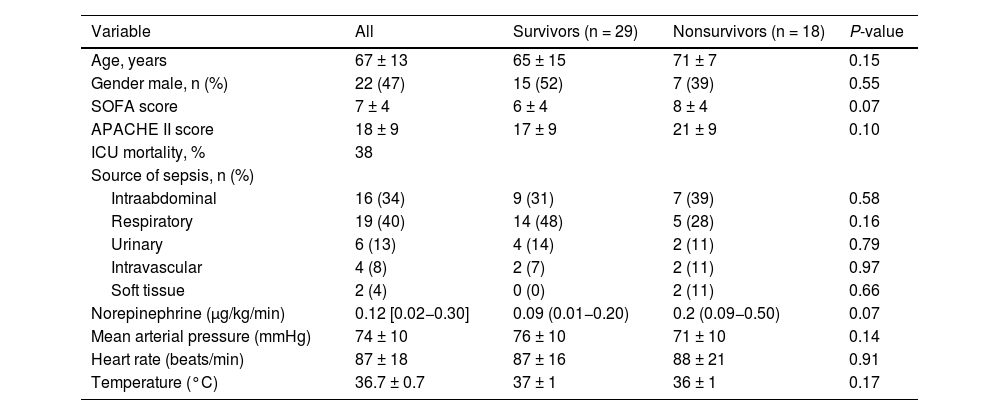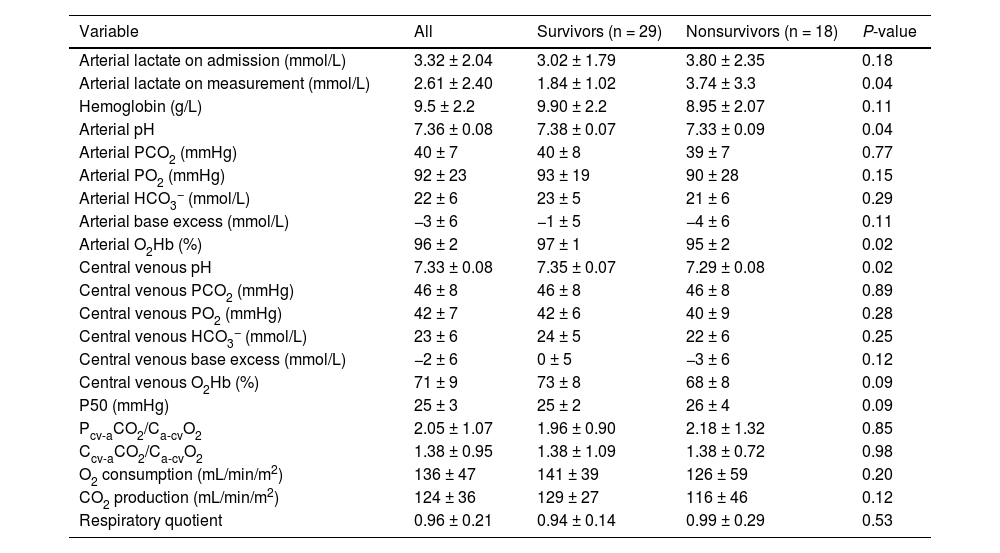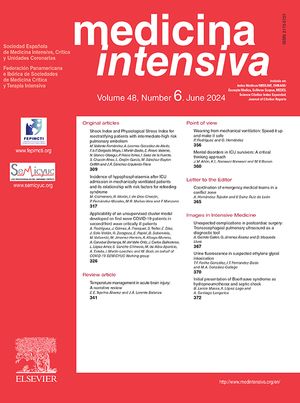Central venous-arterial PCO2 to arterial-central venous O2 content ratio (Pcv-aCO2/Ca-cvO2) is commonly used as a surrogate for respiratory quotient (RQ) and tissue oxygenation. Although Pcv-aCO2/Ca-cvO2 might be associated with hyperlactatemia and outcome, neither the interchangeability with RQ nor the correlation with conclusive variables of anaerobic metabolism has never been demonstrated in septic shock. Our goal was to compare Pcv-aCO2/Ca-cvO2 and RQ in patients with septic shock.
DesignProspective, observational study.
SettingTwo adult ICUs.
PatientsForty-seven patients with septic shock on mechanical ventilation with stable respiratory settings and vasopressor dose after initial resuscitation.
InterventionsNone.
Main variables of interestWe measured arterial and central venous gases, Hb, and O2Hb. Pcv-aCO2/Ca-cvO2 and the ratio of central venous-arterial CO2 content to arterial-central venous O2 content (Ccv-aCO2/Ca-cvO2) were calculated. RQ was determined by indirect calorimetry.
ResultsPcv-aCO2/Ca-cvO2 and Ccv-aCO2/Ca-cvO2 were not correlated with RQ (R2 = 0.01, P = 0.50 and R2 = 0.01, P = 0.58, respectively), showing large bias and wide 95 % limits of agreement with RQ (1.09, -1.10−3.27 and 0.42, -1.53−2.37). A multiple linear regression model showed Hb, and central venous PCO2 and O2Hb, but not RQ, as Pcv-aCO2/Ca-cvO2 determinants (R2 = 0.36, P = 0.0007).
ConclusionsIn patients with septic shock, Pcv-aCO2/Ca-cvO2 did not correlate with RQ and was mainly determined by factors that modify the dissociation of CO2 from Hb. Pcv-aCO2/Ca-cvO2 seems to be a poor surrogate for RQ; therefore, its values should be interpreted with caution.
La relación entre la PCO2 venosa central-arterial y el contenido arterial-venoso central de O2 (Pvc-aCO2/Ca-vcO2) se emplea comúnmente como sustituto del cociente respiratorio (CR). Aunque la Pvc-aCO2/Ca-vcO2 puede asociarse a hiperlactacidemia y mayor mortalidad, la intercambiabilidad con CR y la correlación con variables definidas de metabolismo anaeróbico no se han demostrado en el shock séptico. Nuestro objetivo fue comparar Pvc-aCO2/Ca-vcO2 y CR en pacientes con shock séptico.
DiseñoEstudio observacional y prospectivo.
ÁmbitoDos UCIs de adultos.
PacientesCuarenta y siete pacientes con shock séptico, ventilados mecánicamente, y con condiciones respiratorias y dosis de vasopresores estables, luego de la resucitación inicial.
IntervencionesNinguna.
Variables de interés principalesSe midieron gases arteriales y venosos centrales, Hb y O2Hb. Se calcularon Pcv-aCO2/Ca-cvO2 y la relación entre contenido venoso central-arterial de CO2 y el contenido arterial-venoso central de O2 (Cvc-aCO2/Ca-vcO2). El CR se determinó por calorimetría indirecta.
ResultadosPvc-aCO2/Ca-vcO2 y Cvc-aCO2/Ca-vcO2 no correlacionaron con CR (R2 = 0.01, P = 0.50 and R2 = 0.01, P = 0.58, respectivamente) y tuvieron amplios sesgos y límites de concordancia del 95 % (1.09, -1.10−3.27 y 0.42, -1.53−2.37). El modelo de regresión lineal múltiple encontró Hb, PCO2 venosa central y O2Hb, pero no CR, como determinantes de Pvc-aCO2/Ca-vcO2 (R2 = 0.36, P = 0.0007).
ConclusionesIn pacientes con shock séptico, Pvc-aCO2/Ca-vcO2 no tuvo correlación con CR y estuvo determinada principalmente por factores que modifican la disociación de CO2 desde la Hb. Pvc-aCO2/Ca-vcO2 parece ser un pobre sustituto de CR y sus valores deben interpretarse con precaución.
Article
Go to the members area of the website of the SEMICYUC (www.semicyuc.org )and click the link to the magazine.









